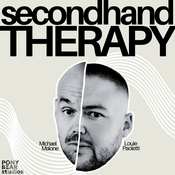33 episodes

When You’re Flying While They’re Celebrating: Tools for Working During the Holidays
12/10/2025 | 47 mins.
Episode 24 When you’re on duty while the rest of the world slows down, the emotional load can hit hard. Loneliness, fomo (fear of missing out), and the quiet ache of missing rituals that anchor you are common experiences to many pilots. In this episode we’ll share five counter-intuitive, highly practical strategies for navigating holiday duty with clarity and compassion. From acknowledging the “suck,” to scheduling a worry appointment, building small mission-based rituals, unhooking from old emotional stories, and finding connection through service, this conversation reframes holiday work as something you can approach with intention—not avoidance. Whether you’re in the cockpit, the cabin, or supporting others behind the scenes, these tools help you stay grounded, human, and connected—even from miles away.

Posture, Prevention, and the Vestibular Edge with Dr. Wagner
11/26/2025 | 1h 14 mins.
Episode 23 In this episode of The Calm Cockpit, Dr. Beth Wagner—Doctor of Physical Therapy and vestibular specialist—shares science-backed strategies for keeping pilots physically ready, resilient, and confident in the cockpit. We cover proactive posture fixes, simple in-flight reset routines, practical vestibular training to reduce motion sickness and spatial disorientation, and accessible ways pilots can seek preventative care without triggering medical reporting. Dr. Wagner offers clear, actionable guidance to help pilots reduce pain, improve focus, and support long-term career health. Dr. Wagner and Gita also discuss motion sensitivity and motion sickness in pilots.They share the specific protocol Gita–with Beth’s educational tools–is using to help train her midlife pilot brain to handle the sensations of flight and to proactively expose her system to motion in a safe environment. This has helped Gita decouple the physical sensation of movement from the anxiety of getting sick as well as provide exposure therapy on days where she isn’t flying. This discussion is a start at making a roadmap of ideas for other pilots of how to take the tools Beth provides and turn them into a real-world training tool. Listen to This Episode If You Want To: Prevent neck and back pain during long duty days Improve in-cockpit comfort, alertness, and focus Understand spatial disorientation and motion sickness Build a personalized wellness and movement routine Access PT support without jeopardizing flight medicals Strengthen your vestibular system through simple daily exercises Links to Beth’s Website: Movement & Function Physical Therapy Videos mentioned in the show: Beginner Vestibular Rehab Exercises- Motion Sensitivity, Imbalance, Vertigo Foam Roller Spinal Alignment Body Scan Relaxation Progressive Muscle Relaxation Eye Massager Review

High-Performance Preparation: Five Evidence-Based Strategies for Aviators
11/12/2025 | 1h 6 mins.
Episode 22 Every pilot knows how to prepare their aviation game for big events like checkrides and recurrent training; but how often do we focus on identifying and using the peak performance strategies that begin long before takeoff? Drawing from neuroscience, physiology, and professional training principles, this episode reframes preflight preparation as a comprehensive human performance discipline; where physiological balance, cognitive efficiency, and emotional regulation are as essential as technical skill. We’ll outline five holistic and evidence-based strategies that build resilience, reduce anxiety, and enhance cognitive precision. Each of the five strategies targets key factors in optimizing our performance: hydration, a work-load reduction plan, meditation and visualization, getting outdoors, and food planning/ nutrition. By integrating these grounded, science-based preparation strategies, aviators can enhance self-regulation, situational awareness, and decision-making—ensuring we bring both technical proficiency and psychological readiness to every flight. Links mentioned in the show: Off The Farm-Premium Protein & Meal Bars Dr. Stacy Sims’ TEDxTauranga Talk "Women are Not Small Men: a paradigm shift in the science of nutrition" Mile High Health Club:workouts and nutrition for aviators from Lashae Bacon Hydration for Peak Performance; podcast with Dr. Sims and The Proof with Dr. Hill Outline/Script for Reverse Visualization Technique: Reverse visualization is a mental performance technique used to speed up performance outcomes and also to cut through anxiety by training the mind for success. It's useful for moments when a goal feels too overwhelming or monolithic, or when training starts to feel "blah" and so repetitive it feels like you'll never reach the finish line. This technique involves starting at the successful outcome and quickly tracing the key steps backward. 1. Identify and Picture the Successful Outcome The first step is to establish the desired goal as if it has already been achieved. This is your starting point for the reversal. Make it Concrete: For a specific event, such as a check ride, visualize the immediate aftermath of success, such as standing with your instructor, shaking hands, and holding your new certificate. Cultivate the Emotional State: This is a crucial element: you must actively cultivate the emotional state of the success, achievement, or result you desire. You must truly feel the certainty, calmness, and competent authority in your body. A visualization that uses neutral or flat emotion will not have the same impact on the brain. Imagine Vividly: The visualization must be so vivid that it lights up the same areas of the brain as if you were actually performing the task. The goal is to convince your brain it's happening to promote neuroplasticity. (As an example of vividness, visualizing biting into a lemon should be strong enough to cause salivation.) Use First-Person Perspective: See the experience happening as if you are in the plane or in the scenario, not from a third-person view. 2. “Walk the Target Back” ala Tammy Barlette aka The Reverse Sequence After clearly establishing the successful ending, you walk the steps backward, often quickly, using key moments. Reverse Quickly: Visualize the sequence in reverse, similar to dragging a slider bar backward on a video stream, and do it relatively fast so that you don't get bogged down. Pick Key Moments: You do not need to go through every single maneuver or detail. Instead, select a few key points. Example Sequence: Start with the moment of certification/hugging the instructor. Walk back to the successful landing. Walk back through the execution of maybe two specific maneuvers (e.g., steep turns, short field landings). Zip back to the pre-flight. Zip back to the moment you choose as your true starting point, such as sitting in your car or at your house the morning of the event. Reinforce the Feeling: During each reversed key moment, cultivate the feeling of certainty, calmness, and competent authority. Or, whatever your keywords are for how you want to feel and respond while flying. 3. Duration and Repetition Timing: The entire visualization typically requires only 5 to 7 minutes. Consistency: Practice this a few days in a row, then evaluate how you feel. Learning Curve: The visualization message may sink in quickly. For some, it only takes three or four times for the message to take hold, after which they may no longer need to do it. You are your own best teacher. Additional Advice Self-Instruction: You can record yourself leading the script of the visualization and then listen back to it as a method of training your mind for success. It can be really powerful to hear this kind of script read by yourself; again, you are your own best teacher. Like Henry Ford famously said, “Whether you think you can, or you think you can't--you're right.” So, train yourself to see–and then achieve–the outcome you desire. As always, any questions or comments send us and email, we love to hear from you: [email protected]

Mental Toughness: What Pilots Can Learn from a Police Detective w/Jim Schilling
10/29/2025 | 1h 3 mins.
Episode 21 In this episode, we sit down with Jim Schilling—a 20-year law enforcement officer, Operations Lieutenant in a Major Crimes Unit, and commercially certificated pilot preparing for his CFI checkride. Jim bridges two high-stress worlds: policing and aviation. Through his experience as a detective and peer support leader, he reveals powerful lessons about resilience, performance, and proactive mental wellness that every pilot can use. Jim shares how his department built a systemic model for mental health—including annual therapy check-ins, peer support programs, and family wellness clinics—and how aviation can adopt similar approaches. He introduces the “stress bucket” analogy, explaining how cumulative stress builds over time and why we all need healthy ways to “dump it out.” From using aviation as therapy to recognizing when not to fly, Jim underscores that self-awareness and training discipline are the true foundations of safety. His mantra says it all: “You don’t rise to the occasion—you fall to your highest level of education and training.” We also explore why silence fuels stigma, how talking openly can save lives, and how aviation can evolve toward a culture of shared wellness and resilience. Key Takeaways: Mental health isn’t weakness—it’s part of your system of readiness. The “stress bucket” reminds us to process trauma before it overflows. Even “aviation therapy” requires an I’M SAFE checklist. In a crisis, you fall to the level of your education and training—so train intentionally. Silence isolates; conversation connects. Jim also shares his creative journey as host of Flying Midwest Podcast and AeroExploration, where he inspires others to find joy, perspective, and purpose through flight. Follow Jim Schilling: AeroExploration Podcast — YouTube and Podcast Platforms Flying Midwest Podcast — homepage for Flying Midwest Media

Bonus: Training the Mind; A Guided Meditation for Focus and Clarity
10/16/2025 | 14 mins.
Bonus Episode Take a moment to shut off autopilot and use this guided meditation to train your ability to choose your focus, steady your mind, and carry calm clarity into your day. This meditation is designed to train one of the pilot’s most essential skills—the ability to choose and sustain focus. The 20-minute practice leads you through five progressive phases: physical and mental preparation, setting a clear intention, controlled breathing with the 4-7-8 method, a core focus exercise centered on the breath, and a gentle conclusion that bridges meditation into everyday awareness. Rooted in deep practice and neuroscience, this meditation emphasizes gentle self-correction over perfection—helping you build calm clarity and steady focus whether you’re in the cockpit or navigating daily life. General Tips for Success: If you’ve ever tried to meditate, you’ve likely been told to “clear your mind” or “just breathe.” This advice, while well-intentioned, can quickly lead to frustration. The mind, by its nature, thinks. Trying to force it into a state of perfect emptiness often feels like trying to flatten a wave in the ocean—an impossible, exhausting task. You might conclude that you’re simply “bad at meditation.” But what if the goal isn't an empty mind? What if meditation is less about achieving a perfect state of silence and more about learning a series of practical, concrete skills to manage your awareness? A single guided meditation can reveal a surprising number of these techniques, small but powerful lessons that reframe the entire practice. They show that meditation isn’t a mysterious state you fall into, but a skill you build through learnable, actionable steps. Here are four ideas to explore from this meditation session; these ideas reveal the practical mechanics of training your attention—and they have little to do with forcing your mind to be blank. 1. Your Focus Starts in Your Feet This meditation begins with a simple, physical act: setting your feet. Place them hip-width apart and ensure they are evenly balanced on the floor. This isn't just about getting comfortable; it's a strategic first step in directing your awareness. Of the 27,000 nerve endings in the body, a large number of them are in the hands and the feet. By consciously setting your feet up, you begin to cue the nervous system that it is time to train the awareness but in a relaxed way. This simple physical adjustment acts as a powerful signal, grounding your attention in the present moment through tangible sensation. It’s a profound, counter-intuitive insight: before you can effectively direct your mind, you must first anchor your body. 2. The Surprising Power of a Longer Exhale Once settled, begin a specific breathing technique known as 4-7-8 breathing: inhaling for a count of four, holding for seven, and exhaling for a count of eight. While many breathing exercises exist, the key to this one lies in a simple ratio: the exhale is twice as long as the inhale. This extended exhale is a direct, physiological command to the body. It actively signals the nervous system to relax, gently easing you out of a state of stress or mental busyness. It’s a deliberate tool, not a passive observation of the breath. This practice activates the vagus nerve--a cranial nerve that extends all the way into your vital organs--which is responsible for activating your parasympathetic nervous system, putting you in a state of relaxed attention. Please prioritize gentleness and and finding a breath pace that feels good for you; this is more important than a rigid adherence to the counting. If at any time the breath feels rushed or pinched, find a pace of breathing that feels more suitable for you. Always adjust and accommodate. 3. You're Not Failing When Your Mind Wanders Here is the most liberating lesson for anyone who has struggled with a "busy mind" during meditation. The goal is not to stop thoughts from arising. It is normal for our thoughts to come and go. The real practice is in how you respond when they do. Practice neutrally observing the thoughts, gently give it a label—"thinking, judging, worrying"—and then guide your awareness back to the breath. The work isn't in achieving perfect, unbroken focus. The work is the act of returning. Each time your mind wanders and you gently bring it back, you are successfully performing the core exercise of the meditation: strengthening your ability to refocus. It's enough to sit to watch the breath, notice the thoughts and then come back to the breath. Give yourself permission to reframe the experience of distraction. A wandering mind isn't a sign of failure; it is the very opportunity to practice the foundational skill of meditation. 4. The 'Firm Resolve' That Changes Everything Before the core practice of watching the breath, this practice begins with a crucial, often overlooked step: setting an intention. Your intention is not as a fleeting wish, but rather a deliberate act of mental direction. Let your mind set a firm resolve for the rest of your practice, for this mediation we will use "may I be calm and clear." You may use any intention that speaks to your personal goals. No matter what, make you intention firm and solid so that it can direct your mind. This is what elevates the practice from passive sitting to active training. By making the resolve firm and solid, you are forging a tool—kinda of like a rudder for your attention. It creates a clear objective that your mind can return to, giving it a distinct purpose and direction for the entire session. Meditation is not a test of perfection but a practice of gentle course correction. The true skill lies not in achieving a permanent state of stillness, but in the repeated, kind act of noticing, guiding, and returning. It's in grounding your feet, extending your breath, refocusing your attention, and setting your resolve. Enjoy, experiment, and happy meditating!
More Health & Wellness podcasts
Trending Health & Wellness podcasts
About The Calm Cockpit Podcast
Listen to The Calm Cockpit Podcast, Secondhand Therapy and many other podcasts from around the world with the radio.net app

Get the free radio.net app
- Stations and podcasts to bookmark
- Stream via Wi-Fi or Bluetooth
- Supports Carplay & Android Auto
- Many other app features
Get the free radio.net app
- Stations and podcasts to bookmark
- Stream via Wi-Fi or Bluetooth
- Supports Carplay & Android Auto
- Many other app features


The Calm Cockpit Podcast
download the app,
start listening.







































